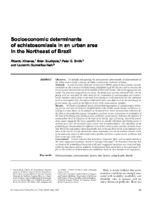Socioeconomic determinants of schistosomiasis in an urban area in the Northeast of Brazil
Date
2003Metadata
Show full item recordAbstract
OBJECTIVE: To identify and quantify the socioeconomic determinants of schistosomiasis in the urban section of Säo Lourenço da Mata, a town in the Northeast of Brazil. METHODS: A cross-sectional study was carried out in 1988 to measure the prevalence of schistosomiasis in Säo Lourenço da Mata among individuals aged 10-25 years and to estimate the socioeconomic characteristics of the households of those individuals. Household aggregation was tested. The data were analyzed on two levels, the family level and the individual level. On the family level we estimated the odds ratios for the association of schistosomiasis and socioeconomic variables related either to the head of the family or to the household. On the individual level we investigated if for the infected individuals there were differences in the intensity of infection (mean egg count) for the different levels of the socioeconomic variables. RESULTS: We found a significant degree of household aggregation of schistosomiasis (allowing for sex and area of residence (neighborhoods with similar socioeconomic conditions, according to census data)). In the analysis on the family level, better socioeconomic indicators for the place in the productive process (occupation, economic sector, and position in production of the head of the family, plus family income) and better socioeconomic indicators for patterns of consumption (level of education of the head of the family, type of housing, household possessions, water supply for the home, sanitation (that is, excreta collection), and family access to medical care) were all associated with a lower risk of schistosomiasis. The estimation of the probability of schistosomiasis for different levels of the socioeconomic variables showed a lower risk (0.072) for individuals whose households were at the top (best) levels of the indicators relative to the risk (0.715) for individuals whose households were at the baseline (lowest) levels of the indicators. Infected individuals whose families had better socioeconomic conditions had lower mean egg count values. CONCLUSIONS: Control measures that may have a long-term effect, such as improvements in the water supply and sanitation, should be strongly encouraged. The theoretical reduction that we found in the probability of being infected if water supply and sanitation were improved highlights the importance of these measures. Implementing them would have a more permanent effect on the control of schistosomiasis and would...(AU)
Subject
URI
http://www.scielosp.org/scielo.php?script=sci_arttext&pid=S1020-49892003001100006https://iris.paho.org/handle/10665.2/8296
Citation
Ximenes, Ricardo,Southgate, Brian,Smith, Peter G,Guimaräes Neto, Leonardo (2003) Socioeconomic determinants of schistosomiasis in an urban area in the Northeast of Brazil. Rev Panam Salud Publica;14(6) 409-421,dic. 2003. Retrieved from http://www.scielosp.org/scielo.php?script=sci_arttext&pid=S1020-49892003001100006
Collections

